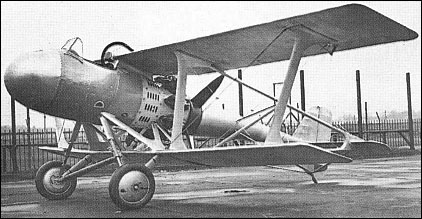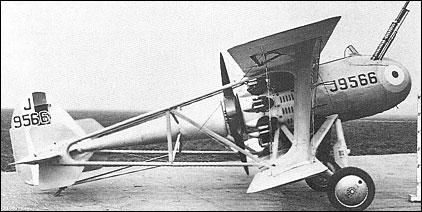|
| In the mid 'twenties, the British Air Ministry found attractive the possibility of the 37mm COW (Coventry Ordnance Works) gun for use against bombers. Accordingly, Specification F.29/27 was issued calling for a single-seat dedicated bomber-interceptor armed with this large and heavy weapon. The specification called for the gun to be mounted in a fixed position to fire forward and upward at an oblique angle of at least 45°. Provision was to be made for oversize and automatically-fed ammunition clips totalling 50 shells, the entire COW gun mechanism had to be easily accessible to the pilot and steadiness as a gun platform was a prime requisite. Vickers submission to this Specification, the Type 161, was extraordinary in that it reverted to the long-abandoned pusher biplane formula with tail surfaces carried by booms. Despite its archaic configuration, however, the Type 161 embodied some advanced features and became the subject of a single-aircraft Air Ministry contract. An unequal-span two-bay biplane with comparatively high aspect ratio wings with duralumin plate and tube structure, it had a metal mono-coque nacelle, accommodating the pilot to port and the COW gun to starboard, which was faired into the upper wing and raised above the lower wing by splayed N-type struts. The 530hp Bristol Jupiter VIIF nine-cylinder radial carried at the rear of the nacelle drove a four-bladed propeller, aft of which was a curious, long tapered cone which, intended to promote directional stability, was supported by struts from the tubular tail-booms and the tailplane. The Type 161 was flown for the first time on 21 January 1931, and after provision of a broader-chord rudder, it flew extremely well, arriving at Martlesham Heath in September 1931 for official eval-
uation. Development was discontinued when official interest in promoting the quick-firing COW gun lapsed.
 | A three-view drawing (1280 x 824) |
| WEIGHTS |
| Take-off weight | 1520 kg | 3351 lb |
| Empty weight | 1080 kg | 2381 lb |
| DIMENSIONS |
| Wingspan | 9.75 m | 32 ft 0 in |
| Length | 7.16 m | 24 ft 6 in |
| Height | 3.76 m | 12 ft 4 in |
| Wing area | 25.08 m2 | 269.96 sq ft |
| PERFORMANCE |
| Max. speed | 298 km/h | 185 mph |
| Klaatu83, e-mail, 14.10.2015 21:55 Vickers built this is 1931? It looks more like something from 1915! The specs insist that this contraption could do 185 mph, but I find that very hard to believe. Put yourself in the position of a RAF fighter pilot in 1931 and ask yourself which would you prefer, this or the Hawker Fury? reply | | guba, 21.06.2011 05:31 I would like to find some reasonable drawings of this aircraft and make a flying model to see how well it flew could be next reply | | Phil Copeland, e-mail, 19.01.2011 07:07 This Vickers 161 seems to be updated on theme of the WW1 Gunbus. One wonders what havoc the 37mm gun could have wreaked on the trundling bombers of the early '30s. reply | | chris malthouse, e-mail, 20.07.2007 16:44 being an ex vickers apprentice I remember seeing a photo of this plane in the apprentice training school back in 1967.
I would like to find some reasonable drawings of this aircraft and make a flying model to see how well it flew could be next project? reply |
|
Do you have any comments?
|
| 
COMPANY
PROFILE
All the World's Rotorcraft
|








